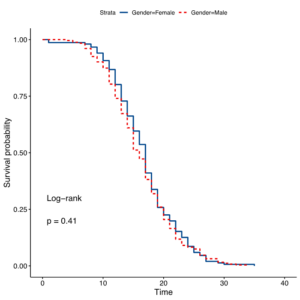The making of a professor: a multi-register large-scale survival analysis of gender disparities in medical science and natural science
By Ulf Sandström (Forskningspolitik)
Posted on October 10th 2022
Research grants are, in many countries, a necessary part of the academic career. Receiving a grant affirms previous work and enables new endeavors. In a forthcoming paper, we raise the following questions: to what extent do research grants influence careers in science, and to what extent do we find gender disparities in the allocation of grants and promotions within academia?
We explore those questions using a data set of 2,727 researchers with Swedish PhD-dissertations from 1985 to 1994 in the medical or natural sciences faculty areas. These PhDs are followed until 2020 – an entire or a significant part of each PhD’s academic career (Sandström & Sandström forthcoming).
The point of departure is that success rates do not offer adequate information to indicate gender disparities. Therefore, we use publication performance measures (journal quality) to mimic how panels at research councils and funding agencies evaluate applicants. That is in line with the method used in the high-profile paper by Wold and Wennerås in Nature (1997). However, we perform fractionalization and field normalization to make the indicator more comparable between subject areas.
In the first part of the study, we evaluate potential gender disparities in grant allocation using regression analysis of application data. These data come from project registers held by Swedish funding agencies. In order to have all possible applications connected to the 2,727, we had to collect 360,000 applications from twelve different agencies. The results of the analysis feed into the subsequent analysis – time to a professorship – where we study the indirect impact of the grant allocation on the promotion to a professor.
The second part of the study includes an Event History Analysis (often called survival analysis) to discern career patterns (see Fig. below). We employ data from personnel registers from Swedish universities to determine when researchers in our study received the professor title. The definition of “professor” includes several categories; chair, promoted, deputy, acting, guest, and adjunct; by the way, a definition used by Statistics Sweden.
In addition to career and application registers, data on research publications are vital for the analysis. They are parts of the researchers’ merits and how they build their careers. Panels assigned by the funding agencies evaluate the merits, and that process also builds the groundwork for the steps to a professorship in which candidates, to a great deal, are evaluated based on publication activity and grant achievements. Performance indicators serve as proxies for the merits of the researcher at given times of their careers (e.g., when applying for grants and competing for a professor position).
We try to explain gender differences in the career to a professorship using variables for academic performance (fractional counts and journal quality) and the number of approved grants. We control for age at PhD, and include interactions into the analysis for each separate area of science.


Please note that the curves displayed do not consider publication and grant performances per gender. The effect of the latter factors is discussed in the blog post.
Results go in different directions
Findings indicate that grant success rates and performance scores are consistently higher for men than women (in the medical and the natural sciences). Also, it is notable that publication performance consistently has a statistically significant positive effect, both on grant success and on promotion to a professor for women and men.
The paper presents results based on a periodization that partly goes along a standard time for becoming an independent principal investigator and partly on policy changes in the research councils. Here, results are presented separately for the two areas. As we shall see, the results are not the same in these two worlds.
Medical research
In the first period, before 1997, most researchers that applied to the medical council (MFR) were at the post-doctoral level and possibly still strongly connected to their supervisor and home department. Such a dependency might affect the quality of the reviewers’ work. Also, this period was before significant policy changes related to gender equality. Possibly there were severe limitations to the panel’s capability to assess the worth of young female applicants; a finding we would say is in line with the Bornmann-Marsh hypothesis (2009), young female investigators had a hard time in research councils, and councils seemed apt to put trust into promises from young male applicants.
In the next period, 1997 until 2005, this had changed, partly as applicants became more and more independent researchers and, partly, as a consequence of the Wold effect: women’s success rates went up by about ten percentage points after the intervention by Wennerås and Wold in 1995 and peaked in 1997 with the publication in Nature (Sandström, 2000).
At the same time, we know that success rates do not reveal the complete picture. More detailed studies concerning the changes in the medical council (Sandström, 2000) indicate that higher success rates came with the prize of lower sums of money for women and men and that women’s projects were far shorter in duration: women were strongly overrepresented in the category of one-year projects. The council gave grants but had little faith in the new female medical researchers.
In the third period, from 2005 until 2020, the implementation of gender mainstreaming policies, based on success rate statistics, created a situation for the sub-council: they seemed to be the bad boy in the family of research councils. However, in our investigation, there is no indication of discrimination in the medical council controlling for factors like performance, age, and rank.
Natural Science Research
The natural science area is represented in the forthcoming paper by two central councils, NFR and SJFR, until 2001 and since 2001, SRC-NT and Formas, making the interpretation more complicated. In the gender policy discussion, natural sciences have designated the good boy. However, our results indicate a consistent male advantage in the funding agencies’ grant allocations, even when controlling for other variables. That holds for the first and last periods. Only in the second period (1997‑2005), which may be affected by Wennerås & Wold, were the allocations more equal.
Grants are essential for the career
A simple analysis indicates no apparent gender disparities in the time to a professorship (see Fig.), neither for the medical area nor for the natural science area.
However, when using controls in the analysis, a potential advantage for women in the medical area is indicated: women have shorter times to professorship than expected when considering merits (publication performance and grants).
As the results indicate that number of grants has a statistically significant effect on time to a professorship in the natural science area, we assume that potential gender disparities in grant allocation may have negatively affected women’s careers (indirectly), especially in the mid-career between 10-15 years after the PhD.
A complicated picture
To conclude, we find a possible gender bias in grant allocation in the area of natural sciences but not in the promotion to professor. In medical science, we find no significant gender disparities, although women possibly have a shorter time to a professorship than expected.
These results are new and deviate from the research councils’ self-understanding. However, further analysis is needed. Firstly, we should investigate whether our findings based on senior researchers in the mid-career and after creates a bias in the selection. It could be that younger researchers meet a different assessment type than the seniors. Secondly, we would suggest going deeper into the mechanisms of gender policies implemented in the research councils. Hopefully, further results of GRANteD and other projects will be able to advance our understanding of these findings.
References:
Marsh HW, Bornmann L, Rüdiger M, Daniel HD, O’Mara A (2009). Gender effects on the peer review of grant proposals: a comprehensive meta-analysis comparing traditional and multi-level approaches. Review of Educational Research 79(3):1290 1326.
Sandström E & Sandström U (forthcoming). Large-scale longitudinal analysis of gender disparities in science careers: how grants impact careers, (submitted).
Sandström U (2000), Forskningsråden, Politiken och rättvisan – studier kring kollegial styrning av forskning. Stockholm: Sister institute report.
Sandström U, Hällsten M (2008). Persistent nepotism in peer review. Scientometrics 74 (2):175-189.
Wennerås C & Wold A (1997). Nepotism and sexism in peer-review. Nature 387, 341-343 (22 May 1997).

